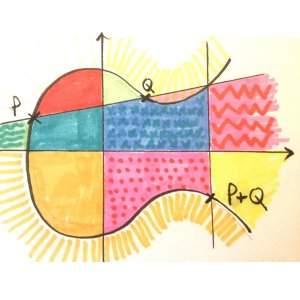Oxford Mathematician Alan Lauder works on elliptic curves and modular forms, and methods for constructing points on the former using the latter. Read more here.
"An elliptic curve is described by an equation of the form \[ E: Y^2 = X^3 + a X + b \] where $a,b \in \mathbb{Z}$ with $4 a^3 + 27 b^2 \ne 0$. One calls solutions $(x,y)$ to this equation points on the elliptic curve $E$. There is an elegant geometric method of "adding'' two points $(x,y),(x^\prime, y^\prime)$ on $E$ to obtain a third point. The set $E(\mathbb{Q})$ of all rational points $(x,y) \in \mathbb{Q}^2$ on $E$, along with a point at infinity, forms a finitely generated abelian group under this operation of addition. One has then \[ E(\mathbb{Q}) \cong \mathbb{Z}^{r(E)} \oplus T \] where $T$ is the finite torsion group and $r(E)$ is called the rank of $E$. Note that $E$ has an infinite number of rational points exactly when the rank is positive.
One expects that the rank is positive around half the time (this expectation is a consequence of the Birch and Swinnerton-Dyer conjecture). So if one writes down an elliptic curve at random, rather remarkably around half the time it will have an infinite number of rational points on it. The difficulty though is to find these points, or rather, some points of infinite order which generate the group $E(\mathbb{Q})$ modulo torsion.
To try and do this, one associates to $E$ a seemingly unrelated object $f_E$ called a modular form of weight $2$. Using this association, there is a complex analytic construction which often allows one to quickly find a point $P$ on $E$ of infinite order. This method of Heegner points was developed in Oxford by Birch in the 1960s and 70s, following the pioneering work of the German school teacher Heegner in the 1950s. The Heegner point $P = (x,y)$ naturally has coordinates in some imaginary quadratic field $K$, but one can choose the field $K$ appropriately to force $P$ to be a rational point.
To an imaginary quadratic field $K$ one can also associate a modular form, but this time of weight $1$. In my work with Henri Darmon and Victor Rotger, using this association we found a new formula for Heegner points. The modular forms of weight 1 which arise from imaginary quadratic fields are of a special form, and there are many modular forms of weight 1 which do not arise in this way. Our new formula still works (conjecturally) for these more general modular forms, but in this case defines points on $E$ over other number fields; namely, over class fields of real quadratic fields, and also fields with Galois group $A_4, S_4$ and $A_5$. The points over class fields of real quadratic fields were first discovered by Darmon twenty years ago using a completely different approach. Our formula gives a unifying perspective on the methods of Heegner and Darmon, as well as defining points in new settings.''
For more on the work click here.


